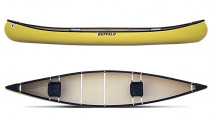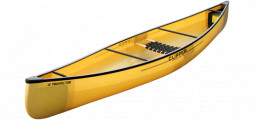The world of whitewater canoeing is wild and wonderful, but it can be an intimidating place for beginners to wade into.
If you’re new to moving water, you might be curious about the wide range of boats designed for whitewater canoeing. Because there are many types of whitewater, there are many boats available, with designs tweaked to match different needs. The best canoe for whitewater will look different depending on where you are, who you’re with, and how much gear you have.
Or maybe you’ve already been down the river enough to wear out or outgrow your current whitewater canoe and are looking for an upgrade. Will you be doing laps of your local play run? Or are you dreaming of next summer’s expedition down the pool and drop rivers of the North?
Whitewater canoes can fall into two broad categories; trippers and whitewater-exclusive boats. Tripping canoes look like standard canoes but have subtle but significant design attributes that result in better control on a river, while still leaving them capable of covering distance on flatwater. Whitewater-exclusive canoes are much shorter and stubbier.
These canoes have an aggressive rocker, giving them a “banana” shape. The paddler kneels on a saddle-style foam seat and is often secured by thigh straps to be totally connected to the boat. When equipped with enough buoyant air bags, it’s possible to roll these canoes with the correct technique.
This guide covers all the open boats that can be used on the river, detailing the different styles and who may want them. Along the way, we list some of the best models and give some helpful buying advice for new and used whitewater canoes.
Shop whitewater canoes
If you know what you want, start browsing through our Paddling Buyer’s Guide to check out the boats offered. Use the filters to view specific types, brands, or materials of whitewater canoes and check out specs and prices. If you’re unsure which type of whitewater canoe is best for you, scroll down to our buying advice.
Top picks: Best whitewater canoes for 2024
The following whitewater canoes have received the highest star ratings by reviewers in our Paddling Buyer’s Guide. See and review all whitewater canoes here.
Best Whitewater Canoes
Shopping for a used whitewater canoe?
Buying a used canoe is a great way to make the most out of your budget. The money you’ll save can go toward other essential pieces of gear like a high-quality paddle or PFD. You’ll need to look hard to find a used whitewater canoe, as they’re a bit of a niche item, but thankfully enthusiasts are constantly swapping boats.
It comes down to a lot of patience and a little luck to find the perfect used boat, but with the right mindset, it’s possible. The following pieces of advice are keys to getting a good deal on the best whitewater canoe for you.
1 Don’t panic-buy
We can’t stress this enough, especially amid all the news of paddlesports’ booming popularity and supply chain disruptions. More people have been getting on the water and buying canoes, but it doesn’t mean you need to pay full price on a used canoe. Pass on the high-balling offers you see posted, more reasonable ones will come along. Waiting until the end of the season will mean that people may be selling boats they didn’t paddle that summer, or outfitters will be clearing out stock.
Another potential mistake is buying a whitewater canoe that doesn’t meet your needs, just because it looks like a good deal. If you are a beginner, be realistic about your ability. It’s a common belief that you can “grow into a boat,” but if the design is too advanced, you won’t be able to develop foundational skills. Remember, we’re all here to have fun.
2 Look everywhere
If you are looking for a used whitewater canoe, Craigslist, Kijiji, MEC Gearswap, Facebook Marketplace and other online classifieds are good places to start. Consider setting up notifications with key search terms so you are notified whenever one is available. On a general classified site like Kijiji, whitewater canoes may be listed simply as “canoes,” so take the time to inspect the photos and inquire.
Infiltrate special interest groups, like regional paddling clubs. Many members sell gear through these sites, or you can even inquire with an ISO (in search of) post.
Another great place to look is an outfitter. Many outfitters sell off their rental fleets at the end of each season to buy new boats. Renting one in the summer is a good chance to try it out and use it in a real tripping scenario. Some outfitters may even put your name down so you can just pick it up in the autumn.
3 Know what to look for
When you are shopping for a used canoe, you should know roughly what kind of boat you want. If you’re unsure, read our Whitewater Canoe Buying Advice below. When you go to see the canoe, there are a few things to pay attention to in particular. The first is how it was stored. Ultraviolet light from sun exposure can do serious damage to a plastic canoe’s hull. It’s best if it was stored in a covered area. Faded spots on the hull may indicate some UV damage.
Whitewater canoes are almost always made from robust plastic, and for good reason. Under the rigorous conditions of whitewater paddling, plastic-based materials bend. If the canoe gets pinned against a rock, it will not crack, even if it gets seriously bent out of shape. Look for folds or creases along the hull. These indicate the canoe was once pinned, before being freed and allowed to regain its original shape. While the canoe is still seaworthy, this may become a weak point in the future, so exercise caution.
4 Be reasonable with the price
Even if it is years old, 50% of the original price is still fair for a well-cared-for canoe. Many whitewater canoes on the used market may not even be in production anymore, but that doesn’t make them worth any less. Don’t waste too much time trying to haggle to save a couple of bucks; you’re probably already getting a pretty good deal.
For more tips on what to look for when selecting a used canoe, read our article How To Buy A Used Canoe.
Whitewater canoe buying guide
There are different options for prospective boat buyers depending on the type of whitewater canoeing you want to do, who you’ll be going with and how much you want to spend.
Styles
Begin by thinking about the type of paddling you do now. Is there a specific thing you wish you could do with your canoe that you cannot do currently? Paddlers can use whitewater canoes in many different ways, and their design reflects these uses. Canoes with foam saddles and thigh straps lock the paddler in, giving greater control in dynamic waters.
These are the most aggressive whitewater designs, with short lengths and plenty of rocker. Often the boats are designed to be filled with flotation bags as well. These boats can paddle and play in CIII waters or greater. Use a canoe like this for slalom, freestyle or creeking.
Whitewater tripping boats are also characterized by having lots of rocker, although they look more like a classic canoe with a carrying yoke and bench seating. The design balances control in moving water with efficiency on the flats. These are suitable for up to CIII water. Anything more than that, you’ll likely be portaging.
Materials
Most whitewater canoes are made with some type of plastic. Rotomolded polyethylene is a common choice, especially for smaller boats, because of its durability and low cost. Proprietary ABS blends like Esquif’s T-Formex use plastic laminate sheets which encase a layer of foam for flotation and durability. Plastic is ideal for beginners and advanced paddlers who plan to charge hard and want a boat that can handle bumps, bashes, and beatings.
Some paddlers do opt for less durable materials in the name of weight and aesthetics. Kevlar whitewater canoes shed excess pounds and save precious energy on wilderness trips. They are easier to carry, and in big whitewater carrying the canoe may be the prudent option. Wood-canvas canoes paddle well on rivers and look great while they do it. The canvas covering the wooden ribs does not handle abrasions well and should only be paddled on rivers with lots of water.
Price
Whitewater canoes range in price depending on the brand and model. Entry-level boats start around $1,800 CAD, and higher-end ones reach past $2,500. The type of material affects the price, and longer boats also cost slightly more simply because they use more resources.
Gear and safety
If you’re new to the sport, you’ll want to set aside some of your paddling budget for proper gear. High-end gear like a drysuit will extend your paddling season and make your time on the water much more comfortable.
Developing sound skills and technical knowledge shouldn’t be overlooked either. If you are just beginning to canoe whitewater, taking a course from a certified instructor is not only a smart move, it’s a lot of fun. This will set you up with the right techniques to get on the water safely and continue to improve your paddling.
These courses are also good opportunities for trying out new canoes. Instructors and other paddlers can give you their opinions on different boats, and you can see them in action. Going to events, like symposiums and festivals, is another fantastic strategy to become part of the community and see what whitewater canoe options are out there.
Want to know more? Find our answers to common questions about whitewater canoes below.
-
What makes a whitewater canoe?
The definition of a whitewater canoe would describe any canoe intended for use on moving water, generally a river. Designs vary greatly, but there are specific characteristics that these canoes all share, like durability and maneuverability.
-
Whitewater canoe vs kayak
Whitewater canoeing and kayaking are both great ways to connect with the water, sometimes even immerse yourself. There are key differences between the two which determine when one is more suited than the other.
Gear capacity is a primary difference, and the open hull of canoes makes them more ideal on extended wilderness trips. In a canoe, there’s space for tents, sleeping bags, food and everything else you’ll need.
Whitewater kayaks are short boats with lots of rocker, so they can pivot quickly. This helps navigate stretches with lots of current, but in calm water, they are pretty slow. Whitewater open canoes, called OC1s, closely imitate whitewater kayaks with their waterline shape and performance characteristics, but they are paddled while kneeling. These are short boats with airbags as flotation. They are used for Class III whitewater and higher, in slalom, surfing, or river running styles.
-
Whitewater canoe brands
Some of the most popular whitewater canoe brands are Esquif and Nova Craft. Many other used boats are made by Dagger and Mad River. These are brands that are still in business but don’t produce dedicated whitewater canoes anymore.
Whitewater canoe reviews
An excellent way to learn more about whitewater canoes is from reading what other paddlers have to say. Check out these reviews, and learn more about what others liked or didn’t like about a boat.
- Inflatable Kayak Review: Sevylor Colorado
- Solo Canoe Review: Old Town Discovery 119
- All-Around Recreational Canoe Review: Pelican 15.5
- Boat Review: Silverbirch Covert Canoe
- Boat Review: Blackfly Option Whitewater Canoe
- Boat Review: Pakboats PakCanoe 170
- Boat Review: Mad River Caption Canoe
- T-Formex Review: Frank Wolf Canoes 1,800 KM To Test New Material
- Esquif Pocket Canyon Canoe Review
- Boat Review: Mad River Legend 16 Canoe














